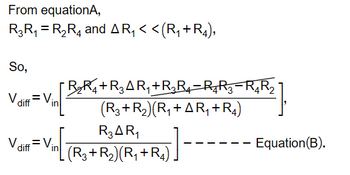Four resistors are used as a Wheastone bridge arrangement. In dynamic deflection operation with R₁ representing a strain gage and R4 representing a potentiometer, the bridge is first balanced by adjusting R4. Va R₂ R₁ Vo differential buffer
Four resistors are used as a Wheastone bridge arrangement. In dynamic deflection operation with R₁ representing a strain gage and R4 representing a potentiometer, the bridge is first balanced by adjusting R4. Va R₂ R₁ Vo differential buffer
Introductory Circuit Analysis (13th Edition)
13th Edition
ISBN:9780133923605
Author:Robert L. Boylestad
Publisher:Robert L. Boylestad
Chapter1: Introduction
Section: Chapter Questions
Problem 1P: Visit your local library (at school or home) and describe the extent to which it provides literature...
Related questions
Question
100%
Please give step by step when deriving the equation given.

Transcribed Image Text:Four resistors are used as a Wheastone bridge arrangement. In dynamic deflection operation
with R₁ representing a strain gage and R4 representing a potentiometer, the bridge is first
balanced by adjusting R4.
Vax
+
R₂
When R, R₁ + AR,
then ou0+ AV
Figure Q1
Then obtain the following expression for the ratio
simplifications. (Please show all your workings.)
RAV
AR,
R₁
out +
R₁ V
ΔΙ
Va
out
Ri
AR₁
by using Kirchoff's volatge law and some
R₁
R₂
R₂ + R₂
Vo
R₂
R₂ + R₂
differential
buffer
amplifier
Expert Solution
This question has been solved!
Explore an expertly crafted, step-by-step solution for a thorough understanding of key concepts.
This is a popular solution!
Trending now
This is a popular solution!
Step by step
Solved in 5 steps with 7 images

Follow-up Questions
Read through expert solutions to related follow-up questions below.
Follow-up Question
how the first line becomes the second line?

Transcribed Image Text:From equation A,
AR₁
R₁₁
AR₁
R₁
=
||
R. ( AVan + R)-(1-4V - R2 + R₂)
R3(AV
R₂
R₂
out
out
R₂ Vi
✓in
+ R3
in
R₂ R3
1
ΔV.
R3
out
R₂
Vin
AV out
Vin
out
R₂
(1-AV-243)
+ R3
+1
AV
R₂
R₂ + R3
Solution
Follow-up Question
how R1 become R1+R4?

Transcribed Image Text:From equationA,
R₂R₁ = R₂R4 and A R₁ < < (R₁ + R4),
So,
R₂R₁+R₂ AR₁+R₂R₁R₁R3-R₂R₂
(R3+R₂) (R₁ + AR₁+R4)
R3AR₁
in (R3+R₂)(R₁+R4).
V diff=Vi
V
diff=V.
Equation (B).
Solution
Follow-up Question
R4/R1 = R3/R2 for balanced wheatstone bridge,
so why isn't the equation look like (1+ R2/R3 + R3/R2 + R2*R3/R3*R2) for the middle part in the image given
![AR₁
R₁
AR₁
R₁
AR₁
R₁
R₂R4 R4
R₂
=
Vouw [(1 + R$ R₁ + R2 + R)]
Vin
=
=
Voule (1+
Nout
V.
Vi
V₁.
R₂
1+2 +
R3
in
2
R₂
+R)².
R3
1+
R₂
R3](https://content.bartleby.com/qna-images/question/9ffb5940-8759-4322-8c6c-95ef762da973/f408458f-4819-409d-9665-89cd7b331651/e8n8ndf_thumbnail.png)
Transcribed Image Text:AR₁
R₁
AR₁
R₁
AR₁
R₁
R₂R4 R4
R₂
=
Vouw [(1 + R$ R₁ + R2 + R)]
Vin
=
=
Voule (1+
Nout
V.
Vi
V₁.
R₂
1+2 +
R3
in
2
R₂
+R)².
R3
1+
R₂
R3
Solution
Follow-up Question
why the denominator is equal to 1 and how to know Vout is very small than Vin ?
Solution
Knowledge Booster
Learn more about
Need a deep-dive on the concept behind this application? Look no further. Learn more about this topic, electrical-engineering and related others by exploring similar questions and additional content below.Recommended textbooks for you

Introductory Circuit Analysis (13th Edition)
Electrical Engineering
ISBN:
9780133923605
Author:
Robert L. Boylestad
Publisher:
PEARSON

Delmar's Standard Textbook Of Electricity
Electrical Engineering
ISBN:
9781337900348
Author:
Stephen L. Herman
Publisher:
Cengage Learning

Programmable Logic Controllers
Electrical Engineering
ISBN:
9780073373843
Author:
Frank D. Petruzella
Publisher:
McGraw-Hill Education

Introductory Circuit Analysis (13th Edition)
Electrical Engineering
ISBN:
9780133923605
Author:
Robert L. Boylestad
Publisher:
PEARSON

Delmar's Standard Textbook Of Electricity
Electrical Engineering
ISBN:
9781337900348
Author:
Stephen L. Herman
Publisher:
Cengage Learning

Programmable Logic Controllers
Electrical Engineering
ISBN:
9780073373843
Author:
Frank D. Petruzella
Publisher:
McGraw-Hill Education

Fundamentals of Electric Circuits
Electrical Engineering
ISBN:
9780078028229
Author:
Charles K Alexander, Matthew Sadiku
Publisher:
McGraw-Hill Education

Electric Circuits. (11th Edition)
Electrical Engineering
ISBN:
9780134746968
Author:
James W. Nilsson, Susan Riedel
Publisher:
PEARSON

Engineering Electromagnetics
Electrical Engineering
ISBN:
9780078028151
Author:
Hayt, William H. (william Hart), Jr, BUCK, John A.
Publisher:
Mcgraw-hill Education,